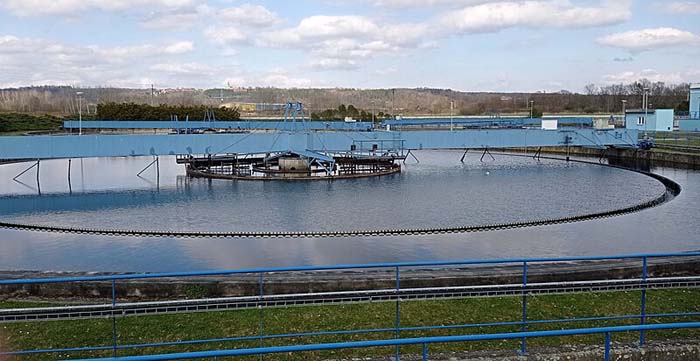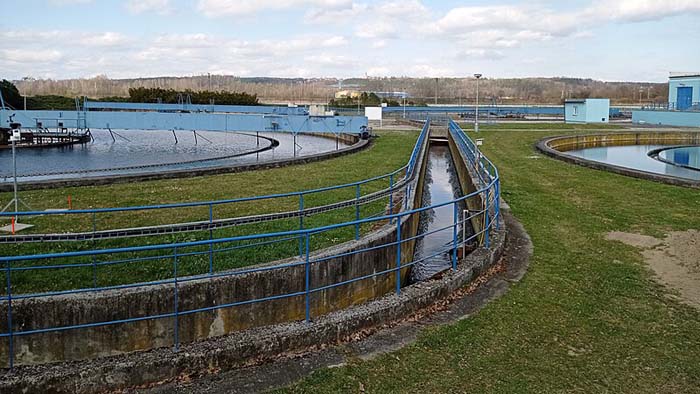
A water treatment plant cleans and treats wastewater before releasing it into the environment. Wastewater refers to water used for purposes other than drinking, such as in agricultural, industrial, residential, and commercial settings. If untreated properly, wastewater can contain toxins and pollutants that are bad for humans and the environment. The fundamental objective of a wastewater treatment plant is to reduce or eliminate contaminants to an acceptable level for reuse or discharge.
This procedure employs a multi-stage physical, chemical, and biological process to eliminate impurities such as toxic substances, nutrients, solids, pathogens, and organic matter.
Here’s a step-by-step guide to wastewater treatment:
Initial Treatment:
- Screening
Before treatment, screens filter wastewater to remove large objects like plastic, rags, sticks, and similar items.
- Removing Gravel
Gravel, sand, and other heavy particles fall to the bottom of the effluent after they pass through the screening process.
Primary Treatment:
- A primary clarifier is a big tank that collects wastewater and allows it to settle for a while.
- Sludge and scum form when suspended materials sink to the bottom of the container, while oil and grease float to the top.
- Next, remove the scum and sludge from the clarified liquid in the center.
Secondary Treatment:
- After clarification, the wastewater goes through biological treatment. Microbes decompose organic materials into water, biomass, and carbon dioxide.
- This procedure usually takes place in trickling filters or activated sludge systems. These provide a controlled environment for wastewater exposure to microbes and air.
- Another option for biological treatment is to use more modern technology, such as sequencing batch reactors or membrane bioreactors.
Tertiary Treatment (Optional):
- Disinfection
After filtration, treat the water with ozone, UV light, chlorine, or another disinfectant to remove any remaining bacteria or viruses.
- Filtration
Membrane, multimedia, or sand filters can help to remove any leftover nutrients, microbes, or suspended solids from treated wastewater.
Treatment and Disposal of Sludge:
- Thickening
Thickening the sludge is a common way to decrease its volume after the primary clarifier and secondary treatment sludge processes.
- Digestion
Anaerobic digestion uses bacteria to break down organic matter in thickened sludge. This leads to the production of biogas (typically methane) and a reduction in sludge volume.
- Dewatering
The next step in reducing the digested sludge’s volume is dewatering it. Filter presses, belt presses, or centrifuges mechanically remove excess water in this process.
- Disposal
Depending on the treatment required to meet regulatory standards, the dewatered sludge can be used as fertilizer on agricultural land, disposed of, or burned. It can also serve other useful functions.
- Wastewater Discharge
Depending on local restrictions and requirements, the treated wastewater is either discharged into receiving waters like seas, lakes, or rivers or reused for industrial or irrigation activities or groundwater recharge. It is now free of dangerous chemicals.

- Monitoring and Compliance
Operators monitor several signs, including nutrient levels, dissolved oxygen, flow rate, turbidity, and pH, while the treatment process is underway to ensure the plant is running well and according to regulations.
Environmental regulations and discharge permits require regular sampling and testing of wastewater quality.
A wastewater treatment plant can protect humans and ecosystems from harmful contaminants by adhering to these protocols.
The benefits of wastewater treatment
There are several social and environmental advantages to wastewater treatment. Among the many benefits, some stand out:
- Enhanced Water Quality
When released back into the environment, treated wastewater benefits downstream users and ecosystems by preserving or improving the overall quality of surface and groundwater resources.
Wastewater treatment is essential to sustainable development because it reduces the demand for freshwater, enhances environmental and public health protections, and bolsters economic development.
- Public health Protection
Proper wastewater treatment can reduce the likelihood of waterborne infections and preserve public health. This removes hazardous pollutants and pathogens.
- Benefits to the Economy
Irrigating crops with wastewater that has undergone the appropriate treatment process can reduce the demand for freshwater sources and associated expenses. Another economic opportunity associated with wastewater resource recovery is the creation of new enterprises and jobs in the wastewater treatment and resource recovery sectors.
- Environmental Protection
Wastewater treatment can preserve aquatic ecosystems and biodiversity. Preventing pollutants from building up helps reduce water body contamination and protects aquatic life and its environments.
- Compliance with Regulations
You can avoid legal fines and penalties for releasing untreated or poorly treated wastewater using wastewater treatment. This guarantees compliance with environmental standards and regulations.
- Reduce the Impact of Climate Change
Anaerobic digestion is one of several wastewater treatment techniques that can generate renewable energy in the form of biogas. One way to decrease the impact of climate change is to generate heat and power from biogas instead of fossil fuels.
- Water Reuse
In certain instances, treated wastewater and industrial and irrigation processes can also be a source of drinkable water. This decreases the strain on freshwater resources, crucial in places where water is already scarce.
- Recovery of Resources
Wastewater treatment can recover organic matter, nutrients (phosphorous and nitrogen), and energy. Reusing these resources helps create a more sustainable and circular economy.
Wastewater treatment FAQs
- How long do wastewater treatment plants last?
Environmental conditions, design, building quality, technology enhancements, maintenance methods, and other factors can greatly affect the lifespan of a wastewater treatment plant.
If built and maintained correctly, a wastewater treatment plant’s typical lifespan is 25 to 55 years. However, the plant’s components might only last a while and need regular renovation and replacement.
Thanks to technological developments and process optimization, a wastewater treatment plant’s lifespan can be increased through proactive asset management, frequent maintenance, and updates to meet population growth and changing regulations. Retrofitting or upgrading existing facilities can enhance their efficiency and extend their lifespan.
- What is removed during primary wastewater treatment?
Primary wastewater treatment mostly employs physical methods to reduce suspended solids and remove solid materials. Primary treatment primarily involves the removal of the following materials:
- Organic solids
Because of their density, certain organic solids tend to settle out during the main treatment process. However, primary treatment cannot completely eliminate organic matter.
- Sand and Grit
In later treatment, grit chambers settle out larger particles such as gravel, sand, and other inorganic materials to avoid abrasion or damage.
- Large solids
Screening is one method for removing these large objects, along with plastics, rags, sticks, and other trash.
Basic treatment still cannot guarantee the removal of all contaminants, particularly dissolved nutrients and contaminants. Secondary and tertiary treatments are useful for more comprehensive purification.
- How are chemicals removed from wastewater?
Wastewater treatment involves removing chemicals from the wastewater. There are a number of approaches, and they all aim to remove specific kinds of pollutants. The following are some typical methods:
Physical Methods:
- Screening:
Wastewater passes through screens to filter out larger particles like plastics, rags, and sticks.
- Settling and Filtration
It is possible to filter out suspended solids and large particles or to let them sink to the bottom of the tank.
Chemical Methods:
- Adsorption
Activated carbon or other substances are used to remove organic pollutants from water.
- Precipitation
The addition of chemicals makes dissolved pollutants insoluble, allowing them to be filtered.
- Coagulation and Flocculation
Chemicals are introduced to wastewater as clumps (flocs) to facilitate their removal by filtration or settling.
Biological Methods:
- Anaerobic Digestion
Bacteria decompose organic materials without oxygen, producing biogas and decreasing the wastewater’s organic content.
- Built Wetlands
Wetland systems filter wastewater by allowing microbes and plants to break down contaminants.
- Activated Sludge Process
Aerated tanks help mix wastewater with microbes, which feed on pollutants and organic matter.
Cutting-edge Treatment:
- Ultraviolet Disinfection
Water treatment plants employ UV light to kill bacteria and viruses by destroying their DNA.
- Reverse Osmosis
High-pressure pumps push water over a semi-permeable membrane to filter out contaminants like dissolved salts.
- Membrane Filtration
Permeable membranes push wastewater through them to filter out viruses, bacteria, and other impurities.
Depending on the wastewater contaminants and the desired water quality, these procedures can work alone or in combination.
- After treatment, is wastewater drinkable?
It is possible to treat wastewater to make it safe for specific uses. However, the level of treatment needed and the specific toxins in the water determines whether it is drinkable.
Advanced treatment methods such as ultraviolet disinfection, advanced oxidation, and reverse osmosis easily remove chemicals, viruses, bacteria, and other contaminants from wastewater. In some regions where water shortages are a big issue, treated wastewater is actually used as a source of drinking water. In common parlance, this is called “water recycling” or “water reclamation.”
 Nevertheless, even after extensive treatment, the possibility of pathogens or residual pollutants remains a concern. To ensure safety, authorities usually establish stringent criteria for treated wastewater for drinking purposes, while regulations and standards for water quality differ by region.
Nevertheless, even after extensive treatment, the possibility of pathogens or residual pollutants remains a concern. To ensure safety, authorities usually establish stringent criteria for treated wastewater for drinking purposes, while regulations and standards for water quality differ by region.
Drinkable treated wastewater is only possible after thorough treatment and strict adherence to regulations.
- What is the easiest to remove from wastewater?
The specific treatment methods used, as well as the nature of the contaminants, determine which pollutants are easiest to remove from wastewater. Physical processes like sedimentation and screening make short work of big particles like gravel, sand, and other solids. Furthermore, skimming and filtering can help to remove grease and oil, among other contaminants, with remarkable simplicity. Advanced filtration, biological treatment, or chemical precipitation methods such as activated carbon adsorption are often necessary to remove dissolved pollutants, such as organic compounds or heavy metals.
- How long does it take to treat wastewater?
A number of factors, including the treatment method, the wastewater’s properties, and the intended level of treatment, can greatly affect how long it takes to treat wastewater. The time required to complete the various biological, chemical, and physical wastewater treatment steps might vary widely.
A number of factors, including the treatment method, the wastewater’s properties, and the intended level of treatment, can greatly affect how long it takes to treat wastewater. The time required to complete the various physical, chemical, and biological wastewater treatment steps might vary widely.
The complexity of the treatment procedure determines how long and different the tertiary treatment process can take. This process aims to remove remaining pollutants and achieve specified water quality criteria.
Depending on the specifics, the total time it takes to treat wastewater might vary from a few hours to a few days or even more. Top of Form
Conclusion
A wastewater treatment plant is responsible for properly treating and disposing of wastewater, which is critical to environmental and human health preservation. Recycling and reusing treated wastewater for non-potable purposes, such as industrial and irrigation activities, contributes to water resource conservation, aquatic habitat protection, and water contamination prevention.
